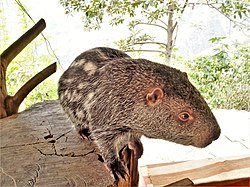Josephoartigasia
Josephoartigasia is an extinct genus of giant rodent from the Pliocene. It is related to the living pacarana. The genus includes the largest known rodent, Josephoartigasia monesi.[1]
| Josephoartigasia | |
|---|---|

| |
| Josephoartigasia monesi reconstruction | |
| Scientific classification | |
| Unrecognized taxon (fix): | Josephoartigasia |
| Species | |
The two species would have looked like gigantic pacarana, or capybaras the size of cows. However, Dr Virginie Millien, from McGill University in Montreal, said the mathematical models originally used to calculate the rodent's mass from its skull probably overestimated its body size.[1]
A recent report said it had big front teeth, which it might have used for defence.[2]
Josephoartigasia Media
The pacarana (above) is the closest living relative of Josephoartigasia
The back of the skull of J. monesi (above) and the pacarana (below), showing their paracondyles (teal for the pacarana)Scale = 5 cm (2 in)
Skull size comparisons between (a) J. monesi, (b) Phoberomys pattersoni, (c) Telicomys giganteus, (d) Neoepiblema acreensis, (e) Tetrastylus intermedius, (f) the guinea pig, (g) the pacarana, and (h) the capybaraScale = 10 cm (3.9 in)
Scimitar-toothed cats like Xenosmilus (above) inhabited Uruguay during the Plio-Pleistocene, alongside Josephoartigasia.
References
- ↑ 1.0 1.1 "Biggest rodent 'shrinks in size'". BBC News. 2008-05-21.
- ↑ Biggest rodent 'fought with teeth' like tusks. BBC News Science & Environment. [1]





